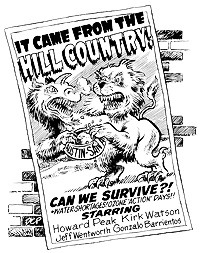https://www.austinchronicle.com/news/1998-05-08/523429/
Corridor Conundrum
The Truth Is Out There on the Highway
By Mike Clark-Madison, May 8, 1998, News
|
|
After a day in San Marcos discussing issues and solutions, here's a theory: The 22-county span from Mountain Home to Schulenburg, and Salado to Dilley, might be a bona fide "region." But it's unlike any we've ever seen before, born out of a mix of forces - social, political, geographic, cultural, economic - quite unlike the dynamic that gave us, say, the Metroplex in Dallas-Fort Worth.
So, two-headed monster though it may be, the "Austintonio" region (a term reviled by folks down Alamo way) is likely not mythical. But if we intend to live in such a place, govern it effectively, and help it thrive - as if we have a choice - we're nonetheless heading into Terra Incognita faster than you can say "the new millennium."
As might be obvious, this conference was whipped together by local planning maven Scott Polikov, under the auspices of the Austin-San Antonio Corridor Council, current doyens of things regional along the Balcones Escarpment. The 22 counties under the regional tent are those composing the two councils of government (COGs) serving Austin/San Antonio - the Capital Area Planning Council or CAPCO (us), and the Alamo Area Council of Governments or AACOG (them).
"Us" and "them," you say? Well, while intramural regional relations are currently more civil than our politicos have ever known before, we have yet to join hands and sing "Kumbaya" with our comrades beyond the Guadalupe River. You could tell this just by counting heads - the idea, or at least the importance, of regionalism seems to carry more weight for us than for them.
As the Corridor Council's own insta-polling of attendees revealed, 85% hailed from the "regional core" - Williamson, Travis, Hays, Comal, and Bexar counties. Of those, more than two-thirds were from the CAPCO side. Though much of the day's talk dealt with the 17 counties outside this "core," they were largely invisible on the floor. (In per capita terms, Hays, Travis, Blanco, Caldwell, and Guadalupe counties were overrepresented, everyone else underrepresented.)
In other words, if a bomb had dropped on Strahan Coliseum, Austin would have been in a peck o' trouble, since that's where Kirk Watson, Daryl Slusher, and Rich Oppel, among the usual suspects, shared a table and heard tell of paradigm shifts and "citistates" of tomorrow. This last term is the coinage of Washington Post columnist and author Neal Peirce, who with partner-in-crime Curt Johnson - chair of the Minneapolis/St. Paul Metropolitan Council, a real regional government - emceed the proceedings.
The Corridor's Core
Interestingly, though, while Watson and San Antonio Mayor Howard Peak, along with State Sens. Gonzalo Barrientos and Jeff Wentworth, occupied high-visibility slots in the agenda, it's the Little Guys who seem to swing more weight. Whether by design or default, it's our "mid-cities" that have taken the regionalism wheel. (The Corridor Council is based in San Marcos.) Underscoring this was the presentation of the Council's "State of the Region" report by Eddy Etheredge and Carter Casteel, respectively the Hays and Comal County judges.
Anyone who really cares about this stuff should run, not walk, toward the nearest copy of this report. For present purposes, a smattering of sobering facts:
* Imagine if a whole new city, the size of Austin today, had sprung up in our parts since 1990. That's what the region's growth amounts to.
* That growth, according to a study by the Carrying Capacity Network, will cost current taxpayers between $6,700 and $8,900 for each newcomer. Remember, in this light, that nearly 60% of Metro Austin's population growth since 1990, and more than 30% of Metro San Antonio's, has come from out of state.
* SWT geography professor Jim Kimmel's land-use modeling predicts that by 2040, if current trends withstand, there will be a swath of development, at least 13 miles wide, stretching continuously from Georgetown to Atascosa County.
The ramifications of this growth on the "Three E's" of the region - equity, economy, ecology - the trinity enshrined by the sustainability movement, are pretty damn obvious and dire. No wonder Johnson described the event as "a day of challenge." And equally small wonder that a man like Eddy Etheredge - a Texas son of the soil if ere there was one - could say, without a blink, things like, "We must learn to grow with grace," or "Urban sprawl must be curtailed," or "We may not have colonias in the true sense in Hays County, but it's not because developers haven't tried."
Again according to the on-site polling, more than 40% of attendees were from the private sector, and - judging from the oft-acknowledged sponsorship list - most hailed from one or another subsector of the sprawl industry. So it took some balls to lay down, early and often, in front of a bunch of road-and-bridge builders and development lawyers, the tone of imminent crisis spawned by growth. But such chutzpah was necessary, for without our troubles, Austin/San Antonio would scarcely be a region at all.
Most "regions" get that way because of a confluence of opportunities that makes the components parts of a whole. Dallas had the oil and the money, Fort Worth the cows and the trains, and together they made a well-rounded socioeconomic unit, and the explosive postwar growth of the terrain between them is no accident. Same with Midland and Odessa, or Minneapolis and St. Paul, or the cities around Puget Sound and the San Francisco Bay.
Austintonio, conversely, is being born of a confluence of crises, of shared disaster rather than shared fortune, of the power of its components to ruin, rather than improve, each others' lives. Right now, this is made manifest on two issues, both discussed in butt-numbing detail at the conference: water and transportation.
Which brings us back to "us" and "them." Water is their problem; despite our agenda-driving concern for water quality, it's San Antonio, not Austin, that's draining the Edwards Aquifer. Transportation is our problem; it's the Capitol City, not the Alamo City, that's choking the life out of I-35. (Carrying 200,000 cars per day, the Town Lake bridge is the most congested point along the highway's entire length, from Laredo to Duluth, Minnesota.)
At the conference this spawned, in the morning, a messy, circular dialogue about SB 1, regional water planning, and the relative powers of the river authorities, most of which sent the Austin attendees (except Bill Aleshire) to the snack tables. After lunch, it was San Antonio's turn to take five, as discussion of SH 130 and rail transit gave the podium to Barrientos and Pete Winstead - development lawyer, Headliners Club fixture, and newly appointed leader of the Texas Turnpike Authority - for some serious grandstanding and ax-grinding.
We Are the World
Of course, the point of our regional paradigm is that - in the words of the conference's accompanying video reel, as intoned sonorously by Cactus Pryor - "we are all connected." Certainly, we have good cause to care that San Antonio is running dry, as do they that Austin is grinding to a halt.
But how does Austin help San Antonio and its neighbors produce a regional water plan that both works and is followed? And how does San Antonio help Austin iron out its convoluted opinions of light rail, commuter rail, and/or SH 130? And how does either city help the rural hinterland educate its citizens, maintain the viability of its agriculture, and keep sprawl at bay? These are the real challenges.
One solution, advanced more than once at the confab, is to give counties ordinance power to regulate land use, which would help deal with sprawl. Also, most agree that an Austin/San Antonio alliance will improve our mutual lobbying power with higher-ups. That helps us more than them, since there really ain't no higher-ups in Water World, which was the message of SB 1: "Figure it out yourselves." Other than transferring water from the Colorado basin (think "blizzard in hell"), Austin's best contribution to a water-supply solution would be a rain dance. (Remember, getting a driblet of water into San Antonio from Canyon Lake, which lies within the Alamo City's official metro area, involved the political relocation of both earth and sky.)
On transport, at least San Antonio can accompany Austin to D.C., and to the Texas Transportation Commission, for the highway-funds slop call, whispering "NAFTA" softly into Congressional and Legislative ears. (As Barrientos put it, unless Something Is Done Now about Austin's mobility problems, we will become the "NAFTA traffic-avoidance zone.") Of course, now that SH 130 has morphed from a freight bypass into a commuter toll road, much to Pete Winstead's delight, its usefulness in the NAFTA context is an open question. San Antonio's influence, potential or actual, over that bright idea is kinda hard to discern.
As for rail, nearly a year after the Barrientos bill authorizing a corridor commuter rail district, Bexar County and the City of San Antonio have yet to sign off on creating it. This is no real surprise since, NAFTA notwithstanding, the I-35 corridor is but one of several S.A.-inbound commuter routes, and likely not the most problematic, even with supergrowth between New Braunfels and Seguin. For the moment, any regional rail talks will have to wait until right-of-way owner Union Pacific Railroad straightens out some rail problems of its own.
Lessons Learned
Austin/San Antonio would surely benefit from regional partnerships, frameworks, collaborations, and other menages - as soon as we figure out what those strategies would be. Perhaps they will spring to life spontaneously once everyone signs off on our shared crisis of unplanned, misunderstood growth; and at highlighting the terms of this crisis, the conference was an unqualified success.
Much of the event was devoted to examples from elsewhere, in particular San Diego, Charlotte, and Chattanooga. All three communities have admittedly succeeded admirably at reinventing themselves as Cities of Tomorrow. But none of them is really a "region" in the Austintonio sense. They may be parts of regions that are likewise being born of crisis and quandary (especially Charlotte), but none of their wisdom helps quash the turf battles and cultural conflicts that separate Austin from San Antonio and both from their hinterlands.
At the end of the day, Howard Peak exhorted the crowd - or, in his word, the "choir" - to "go home and do something" about the regional agenda. What many of them went home and did was deal with the next day's elections, from which the verdict on regionalism is sort of mixed. Just to pick three high points: Austin's Prop. 2 bond got rammed down Hays County's throat, in the estimation of many who live there. San Marcos Mayor Billy Moore, architect of some of the region's more notable collaborations, is trailing his opponent into a runoff. And Cedar Park bounced longtime mayor Dorthey Duckett, under whom the city drafted a comprehensive plan, embarked on a Town Center project, and otherwise did all the right things from the new-millennium angle.
Region though we may be, politics is still a local game. And "How?" is not the only regional question whose answer lays shrouded in the mists of Terra Incognita. There's also "So what?" Joe and Jane Average Middle Texan have never really been polled on regionalism, and, judging from their votes, may not much care for it. "We probably share more concerns throughout the Region than not," the "State of the Region" report notes. Problem is, one of the concerns that everyone around here still shares may be a lingering mistrust of our neighbors.
Copyright © 2025 Austin Chronicle Corporation. All rights reserved.

